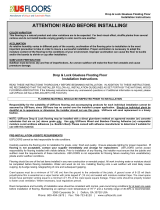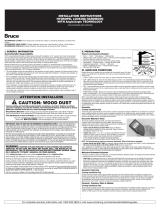Page is loading ...

Installation Instructions: 11-5/8” Cork
JOBSITE CONDITIONS:
• Structure must be completely enclosed (including exterior
windows and doors). Gutters, downspouts, and exterior grading
should direct drainage away from the structures foundation.
Basements and crawl spaces must be dry and well ventilated. Crawl
spacesmustbecoveredatgroundlevelwitha6-milpolyethylenelm
with seams overlapped and tapped completely. Heating and cooling
systems must be operating for a minimum of 14 days, maintaining a
room temperature of 65F and 35-65% RH.
FLOORING ACCLIMATION AND STORAGE:
• Flooringrequires48hoursjobsiteacclimation.Leaveooringin
packaging, and remove plastic wrapping only when ready to install.
Transportandstorecorkooringinalayingposition.Iftheooring
needs to be stored, leave in packaging, laying down raised off of
suboor(fullysupportedtopreventsagging).Storeonlyinaclimate
controlled area, minimum 65F room temperature, between 35-65%
Relative Humidity.
APPROVED INSTALLATION METHOD:
• This ooring features a glueless locking system for oating
installationonly. This ooring is factorynishedandrequiresno
additionalsealing.Note:Thisooringdoesnotrequireacushioned
underlayment as the bottom cork layer serves this purpose. All
installationsdorequireapolyethylenelmmoisturevaporbarrier
as noted in the “Installing The Floor” section.
INSTALLATION LOCATIONS:
• Indoors only, in year round climate controlled rooms (temperature
60-80F, Relative Humidity 35-65%). Cork ooring products are
based on natural materials and will expand and contact through
heating and non-heating seasons thus experiencing some separation
between the planks at different times during the year. Such
separations are not considered a product defect.
• Can be installed ON, ABOVE, AND BELOW GRADE over
mostanydry,at,clean,andstructurallysoundsolidsurfacesuch
asooringgradeplywood&OSBboard,particleboard,concrete,
lightweightconcrete,andsoundlysecuredexistingoors(linoleum,
vinyl, tile, etc.). Do not install over soft surfaces such as carpet. Not
approvedorwarrantedforinstallationinafullbath.Corkooring
planks and stairnose moldings also are not approved for use on stair
treads.
• Can be installed over in-oor radiant heat systems (maximum
82F, maximum 5F temperature change plus or minus in a 24 hour
period). Follow installation instructions of the suboor heating
system manufacturer, contractor, or contact the system supplier.
CHECKING SUBFLOOR FLATNESS:
• Useastraightedgetochecksubooratness.Thesuboorshould
beattowithin.12”(1/8”)ina6-1/2’area.Checkvariousareas
throughoutthesuboor.Highareasneedtobesanded and low
areaslled.Highorlowareascouldcausetheoatedoortoex
causingsqueaking,popping,orothernoises.Overtimethisexing
could cause the locking system to weaken resulting in gaps or loose
boardsintheoor.Neversandanyareaorexistingoororcured
adhesive suspected to contain asbestos or crystalline silica (such
as resilient vinyl or linoleum, or the adhesives used to bond them).
CHECKING MOISTURE CONTENT OF SUBFLOOR:
• All suboors must be dry. Wooden and concrete suboors
require insulation against moisture. See “Installing the Floor” section
for added details.
WOODEN SUBFLOORS:
• Using a reputable manufacturers moisture meter for wood sub-
oors,thesuboormoisturecontentshouldnotexceed14%.Also,
themoisturecontentreadingsbetweenthesuboorandthenew
ooringshouldnotexceed4%.
CONCRETE SUBFLOORS:
• One of the following moisture tests is recommended:
(A) Calcium Chloride Test / maximum 3.0 pounds
(B) Tramex Moisture Meter / maximum reading of 4.5
(C) Delmhorst BD2100 Moisture Meter / reading of green/dry.
LIGHTWEIGHT CONCRETE FLOORS:
• Test as follows:
(A) For concrete screeds / <2,0% CM Instrument
(B) For anhydrite screeds / <0,5% CM Instrument
• Keep documentation of all moisture readings. If results indicate
a moisture problem exists, DO NOT INSTALL THE FLOOR. Most
moisture problems can be corrected easily (sealing, etc..). When
corrected,retestthesuboor.
SUGGESTED TOOLS / MATERIALS:
Polyethylene Film (2 or 6 mil), Adhesive tape, Tapping Block, 3/8”
Wood or Plastic Spacers, Measuring Tape, Safety Glasses, Dust
Mask, Chalk Line, Square, Pencil, Wood Chisel, Circular or Rip
Saw, Jamb Saw
PRE-PLANNING TIPS:
• Inspect ooring in adequate light before installing. Removeany
boardswith visibledefectsor damage. Defectiveooring thatis
returned unused will be replaced. Contact your supplier.
• Slightly bowed (curved) boards can be installed and are not con-
sidered to be defective.
• Wheninstallingooring,alwaysworkfromseveralcartonsblend-
ing lighter and darker boards to achieve a more uniform appearance.
• When cutting or sanding Engineered Cork Flooring it is recom-
mended that you wear a dust mask to avoid inhaling wood dust, and
safety glasses for eye protection.
• A oating oor expands and contracts with the seasons and
shouldneverberestrictedinanyway.Thisoatingoorrequires
a 3/8” expansion space around the perimeter of the room, and
around any vertical object (cabinets, columns, etc.). Be careful not
toputfasteners(nails,screws,etc.)throughtheooror“pinch”the
oorunderdoorways,cabinets,etc..Thiscouldcausetheoorto
pullapartorbuckleifitisnotallowedtooatfreely.Beespecially
careful when installing moldings and trim not to nail through the
oatingoor.
• Decidethedirectiontheooringwillbeinstalledintheroom.If
possible, it is best to install perpendicular to the direction of the
ooringjoists.Flooringwillbeaccentedbestifinstalledparallelto
the largest windows in the room.
• Larger areas require additional expansion space. In areas larger
than 24 ft. length in either direction, allow an additional ¼” space
forevery12ft.inlengthabove24ft.(Example:Fora36’x36’size
room,allow5/8”expansion(normal3/8”plus¼”spaceforthe12’
above24’)aroundtheperimeteroftheroom.
• Pre-plan the number of rows (base off of board face width).
Oftenthelastrowwillneedtoberippedlengthwisetot.Ifthe
measurement for the last row is less than 2”, it would be best to rip
theboardsintherstandlastrowsforbalance.Iftheboardshave
to be narrower that 2”, use a high quality carpenters glue to secure
the boards to the wider adjoining boards.
• Remove any base, shoe, or threshold moldings before installation.

• Undercutdoorjambstoallowforexpansionandtoavoiddifcult
scribecuts.Useasmallpieceofyourooringasarestforthejamb
saw during cutting.
• The use of putty to ll small gaps or correct minor defects is
considerednormalinanyooringinstallation.
INSTALLING THE FLOOR:
Call 1-800-258-5758 for assistance if required.
OVER WOOD SUBFLOORS:
• Loose-lay1layerofpolyethylenelm(minimum2-mil,preferred
6-mil) as a moisture vapor barrier. Overlap the seams of the poly
by 8” and tape the seams completely with clear packaging tape. Poly
should be lapped up the wall but not touching the sheetrock.
OVER CONCRETE SUBFLOORS:
• Loose lay 2 layers of polyethylene lm crossways (minimum
2 mil, preferred 6-mil) as a moisture vapor barrier. Overlap the
seams of the poly by 8” and tape the seams completely with clear
packaging tape. Poly should be lapped up the wall but not touching
the sheetrock.
INSTALLATION TIP:
If you need to cover the oor during or after the installation we
recommend covering with a breathable material such as cardboard, craft
paper, etc.
• (Figure1). Begin layingthe ooring in the right corner of the
room. All boards should be installed with the tongue side facing the
wall. To determine the tongue side, look down directly from above
atthenishedsideoftheboard.Alongbothofthelongsidesof
theboardyouwillseeberboardshowingthatisthelockingcore.
The side with the narrowest amount of core material showing is the
tongue side. This is the side that should face the wall.
INSTALLATION TIP:
Note that slightly bowed (curved) boards can be installed and are not
considered defective. There are a few tips that can help make installing
these boards easier. 1. When placing the bowed board at an angle into
the side groove of the row being installed into, apply pressure to engage
the boards as usual rotating the board downwards. 2. As you meet
resistance, hold the bowed board near its’ center and apply downward
pressure. 3. Use a tapping block to tap against the groove side of
the bowed board while continuing to apply downward pressure until the
board engages and goes into the proper at position. Do not tap too hard
as this can damage the groove side of the board being installed.
• Laytherstboardintherightcorneroftheroomatonthepoly
lm.Install3/8”spacerstomaintaintherequiredexpansionspace
against the wall (and around the perimeter of the room as you
progress) as necessary. Hold the second board at an angle matching
the end groove of the rst and join these twoboards by simply
foldingitdownatontheoor(Figure2).Makesurethatthelong
sides of the two boards form a straight line. Repeat these steps to
completetheboardsintherstrow.Usuallythelastboardinthe
rowwillneedtobecuttosize.Ifleftovercutpiecesarelongerthan
12” they can be used as starter boards for other rows.
INSTALLATION TIP:
• Always stagger the end joints of adjoining rows a minimum of 12”.
Try to avoid a “stair step” pattern, and try to avoid “H” joints in the
installation.
• Figure 3: Start the second row in the right corner by holding
the long side of the rst boardatan angle to the boards in the
rst row. Make sure the tongue of the board being installed is
alignedproperlywiththegrooveoftherstrowboards.Engage
the board sides by rotating the board downward while pressing
forwardtowardtherstrowooring.Useatappingblocktoassist
engaging the board if necessary. (Figure 4) Place the short end of
the next board at an angle against the previously installed board,
press forward to insert tongue into groove, and fold down to join
the ends. Make sure that the board is also aligned tightly in the long
side groove of the boards in the previous row. (Figure 5) Lift this
board (together with the previous one laid in the same row) up
slightly about 1-1/4”, push them against the row in front to engage
tongueintogroove,andthenfoldthemdownwardtoaatposition
to join. Repeat these steps for the other boards in this row. Cut
thelastboardtosizeasnecessary.
INSTALLATION TIP:
Properly engaged boards will lay at. You cannot force the boards to go
together, and if they are not laying at when engaged they are not fully
seated. Disengage the board by lifting the side of the board at an angle to
remove. Reinstall the board and use a tapping block to assist in securing
the boards together until they lay at.
• Install the third and remaining rows in the same manner as
described above. Once three rows have been installed, recheck the
spacers to be sure they are tight against the wall. If necessary, adjust
theooringtobesuretheinstallationissquare(Figure5).
• The boards in the last row often need to be ripped lengthwise
to the needed width (be sure to allow for required expansion
space). Mark the board to be ripped accordingly allowing for any
wall contours as required. The boards in the last row should be at
least 2” wide.
INSTALLATION TIP:
When working under door jambs or the toe kicks of cabinets, there will
not be enough clearance to get enough angle necessary to engage the
board sides. It will be necessary to trim away the raised portion on the
groove side using a wood chisel and then glue the boards together using
a high quality carpenter’s glue.
• After the oor is completely installed, remove spacers, install
moldings and thoroughly clean the oor with an approved
hardwoodoorcleaner(call1-800-258-5758foralistofapproved
cleaners).If theoorneeds tobecoveredforprotection,use a
breathable material like craft paper or cardboard. Never cover a
newlyinstalledcorkoorwithplastic.
Tips For Protecting Your Floor:
• Regularlyvacuumandcleanyouroorwithanapprovedcleaner.
• Protectyour oor by placing walk-off mats at all entrances to
retain tracked-in dirt, grit and moisture. Use breathable mats,….
never use latex or rubber backed mats that can trap moisture that
candamageyouroor.
• Avoidmoistureontheoor.Cleanupspillsquicklyanddon’twet
ordampmopyouroor.
• Use felt pads on chair legs and furniture legs.
• Don’tdragorrollheavyobjectsdirectlyacrossyouroor.Put
down a layer of material such as plywood for protection.
• Avoidwalkingontheoorinhighheeledshoesorsportsshoes
with spikes or cleats,
• OfcerollerchairsmustcomplywithDIN68131.
• Keep pets nails trimmed as closely as possible.
• Theexposuretosun,UVraysandarticiallightingcanfadeor
changethecolorofyouroorovertime.Ifpossible,werecommend
thatyourearrangextures,rugs,andfurnitureperiodicallytoensure
theooragesevenly.Ourwarrantiesdonotcoverdamagefrom
thesun,UVrays,orarticiallight.
/










